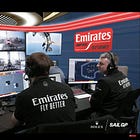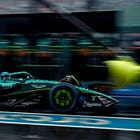Inside the Pit Stop Economy
F1’s 2-Second Masterpiece
You are receiving this email because you subscribed to Business of Speed, the newsletter for those wanting to stay ahead on what’s happening behind the scenes. I’m Vincenzo Landino, a business, tech, and F1 commentator. I’ve spent the last ten years at the intersection of content, partnerships, and the business of motorsport. This newsletter is where I break down what’s working, what’s shifting, and what’s next without the PR gloss. Thank you for being here.
In Formula One, a blink takes 300 milliseconds. That’s how thin the margins are.
And nothing captures this better than the pit stop. On TV, it looks like chaos: twenty mechanics leaping over the wall, wheel guns screeching, a car gone before you’ve registered it arrived. But inside the garage, it’s not chaos. It’s choreography. A two-second routine so precise that championships are built—or lost—on its consistency.
Here’s what it takes.
Each wheel has a three-man crew. One removes, one replaces, one tightens the nut. Jack operators lift 800 kilograms with millimeter precision. Stabilizers hold the car steady while another pair of hands adjusts the front wing. Overseeing it all is the pit-stop controller, their finger on the release system like an air traffic controller clearing a jet for takeoff.
The car arrives, four tires are removed, four new ones are installed, and the nose is trimmed for balance. If everything clicks, the car is gone in two seconds flat. If even one role slips, the race is gone.
“Everyone must always be ready”
That level of speed doesn’t come from raw talent. It comes from design. The tools are engineered to reduce error. Wheel nuts that can’t roll away, axles shaped to guide them in, sensors confirming every lock before the light turns green. Humans are trained like athletes five days a week in the gym, with endless hours of video review and thousands of practice stops until movements become automatic.
I was at the 2024 Las Vegas Grand Prix, staying at the Virgin Hotel. Every morning, I would get in my workout, and every morning, I would be amongst the entire McLaren team.
The entire pit crew, marketing team, even Andrea Stella and Bianca Bustamante were there, putting in strenuous workouts to prep themselves for being on the track.
By the third day, I finally said something to Andrea in Italian, “You’re really getting after it, eh?” to which he smiled at me and said, “Everyone must always be ready.”
What fans remember are the world records: a 1.82-second stop in Brazil, a 1.91 in Silverstone. But teams don’t chase single moments of perfection. They chase the curve. An 80% success rate under 2.7 seconds is more valuable than a single miracle surrounded by failure—consistency compounds.
And then there’s the strategy. A well-timed stop can flip a race on its head. Pit one lap earlier than your rival, and you might leapfrog them on fresher tires. Stretch your stint longer and you might gain clean air while they’re mired in traffic. Throw in safety cars, changing weather, or the nerve-wracking “double stack,” and the pit lane becomes a chessboard played at 200 mph.
Of course, when it fails, the consequences are brutal. A wheel is left loose, and the car is out. An unsafe release, and you’re hit with penalties, fines, and global embarrassment. The FIA has even had to impose minimum time buffers to keep teams from pushing anticipation past the point of safety.
But here’s the bigger story: pit stops are the most efficient operating system in sports. Every role is tiny, but perfectly aligned to a single outcome. Every process is engineered to eliminate error before humans even touch it. Every athlete in the crew trains for repeatability, not heroics.
Twenty-four races a season, two seconds at a time, championships are won in that blur of noise and movement.
And if you run an elite business, that’s what your pit stop should look like.
PS: I’m exploring a “Business of Speed Playbook” series on applying F1 operating models to content, operations, and partnerships. If that’s a fit for your team, reply to this email with “PLAYBOOK” and I’ll reach out.
You are receiving this email because you subscribed to Business of Speed, the newsletter for those wanting to stay ahead on what’s happening behind the scenes. I’m Vincenzo Landino, a business, tech, and F1 commentator. I’ve spent the last ten years at the intersection of content, partnerships, and the business of motorsport. This newsletter is where I break down what’s working, what’s shifting, and what’s next without the PR gloss. Thank you for being here.





